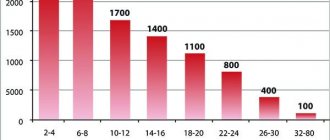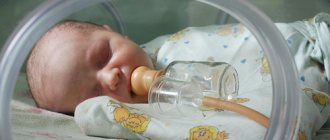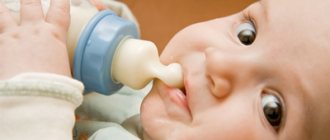Nutritional standards for a three-month-old baby
According to standards, babies at three months should drink 150-180 ml of milk or formula per feeding, this is 1/6 of the weight of a 3-month-old child. The amount of food in ml that a three-month-old baby eats during the day is equivalent both when breastfed and when fed with formula. As practice shows, children who are on guards eat more times a day than children who are on willows.
The fact is that a baby who feeds only on breast milk can suck very little milk from his mother’s breast at one time and will ask for food much more often than the same child eating formula. Artificial babies eat less often because the formula is much more nutritious, and they stay full longer.
Small child in mother's arms
If the baby is breastfed
At three months, the baby, as a rule, has already developed its own individual feeding schedule. The norm for feeding a three-month-old baby on guardianship is considered to be feeding 6-7 times a day and the child consuming up to one liter of mother's milk per day.
It is much more difficult to control the amount of food eaten during breastfeeding, since the mother cannot see how much milk the baby sucked in one feeding. Therefore, if there is a need to control this process, it is necessary to weigh the child on an electronic scale before feeding and after the baby has eaten.
Interesting. When feeding the baby in the morning, a mother needs to understand that she sleeps at night and, accordingly, does not eat food, so breast milk in the morning is not very high in calories. After breakfast, closer to lunch, the milk will become more nutritious.
At night, you should not take a long break between feedings, since it is at night that the hormone prolactin is produced, which stimulates good lactation.

Baby sucks mother's breast
When a child is on artificial nutrition
A three-month-old baby can already drink about 180 ml of the mixture at one feeding. During the day, the child eats 4-5 times during the day and 2-3 times at night, this is much less often than the newborn baby ate at first.
There are two methods for calculating the nutritional norms of a baby at three months. In order to calculate the average nutritional volume, you can use these methods simultaneously.
First method
To calculate how much a child should eat at 3 months, you need to multiply his body weight by 1/7, which will result in the average daily volume of the formula. Next, you need to divide the total volume of the mixture by the number of feedings per day, you will get a single dose that the child needs.
For example, the baby’s weight is 5,460 * 1/7 = 780 ml, this is food for one day. Next 780/5=156 ml. A child will need a total of 156 ml for one feeding.
In reality, it is very difficult for a mother to prepare such an amount of formula, since it is prepared right before giving it to the child. If 150 ml of the mixture was enough for the baby throughout the day, then by the evening, after active play, he will develop a strong appetite, and the same volume of mixture as during the day will not be enough. In this case, you can add another 25 ml to 150 ml, and the amount of mixture consumed will not exceed the average daily norm.
Second method
With this method, the child’s weight and height are taken into account. According to average statistics, a three-month-old baby should eat from 900 to 1050 ml of mixture per day. This norm is divided into the required number of feedings (usually 5-7 times a day).
For overweight children who are actively developing, the volume of formula will be different, not the same as for children with average body weight and height. Children with a body weight above average should eat 900-950 ml of the mixture per day.
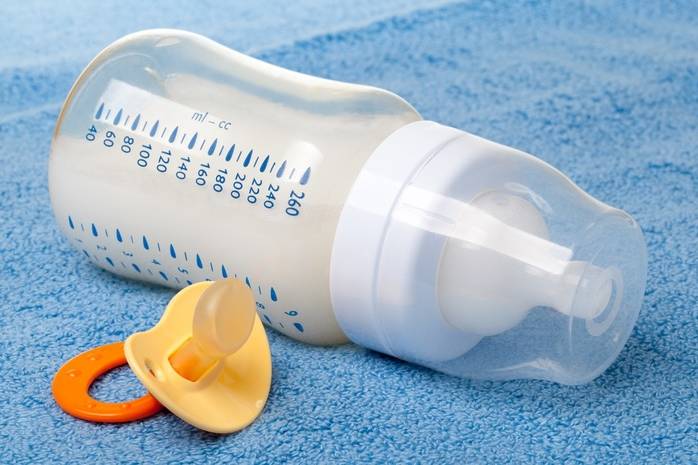
Bottle and pacifier lie on the table
If the child is on mixed feeding
If a mother feeds her baby with breast milk and then supplements her with formula, then calculating the average daily amount of food for a three-month-old baby is quite problematic. An indicator that a baby fed both mother's milk and formula is full is its behavior. If the baby is vigorous, cheerful and sleeps soundly, it means he has enough nutrition.
With this type of feeding, you should first offer the baby a breast, first one, then immediately the second. The mother should do this so that while the child is very hungry, she first eats more nutritious and healthy food. If the mother sees that the baby is not full, then it is necessary to supplement him with formula from a bottle.
For your information. Depending on the amount of milk the mother has, the volume of formula required to supplement the baby may vary. In the third month of life it can vary from 25 to 120 ml.
Babies do not stay on this type of feeding for very long, for the reason that it is very difficult to suck milk out of their mother’s breast, and the mixture from the bottle gets into the mouth without any extra effort. Then the child prefers to drink formula from a bottle more and more often and stops taking the breast.
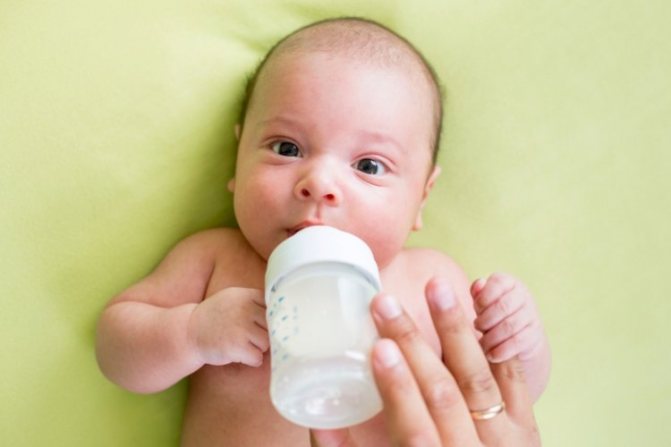
Baby drinks formula from a bottle
Nutritional norms for a three-month-old baby
Children at this age should receive one of two types of nutrition: natural mother's milk or adapted milk formula. The use of cow, goat or mare's milk is not welcomed by pediatricians in our country. How much a baby should eat at 3 months depends on what he is fed.
Breastfed
By the age of three months, an individual diet has already been developed.
Feeding norm for a 3-month-old baby: 6-7 meals a day and consumption of 850-900 ml of mother's milk per day.
It is worth considering the peculiarities of feeding in the morning. At night, mom sleeps, which means she doesn’t eat. Therefore, breast milk in the morning does not have high energy value. And when mommy has breakfast, she will have nourishing milk by lunchtime.
During the night period, the baby should not take long breaks between meals, since the hormone prolactin is produced at night, which is responsible for high-quality lactation.
Artificially fed
At three months, children drink about 180 ml of the mixture at a time. During the day you need to switch to five meals a day.
There is a simple way to calculate the required volume of formula for a child who is 3 months old. on artificial feeding. You need to multiply its weight by 1/7, and you get the daily volume of the mixture. Divide by the number of feedings and get a single dose. For example, a child’s weight is 5,460*1/7=780 ml, this is the amount of food for a day; further: 780/5=156 ml.
But in practice, preparing 156 ml of the mixture is extremely difficult, since it is prepared immediately before eating. If 150 ml of formula was enough for a child during the day, then in the evening, after active games, he may get hungry and the usual amount of food will not be enough for him. In this case, the addition of 25 ml will not exceed the daily norm.
There are exceptions, this applies to children born with high birth weight. For them, it is worth making a calculation based on calorie needs per kilogram of weight. At the age of three months, a child spends 115 kcal per 1 kg of weight.
First, we calculate the baby’s daily kcal requirement based on his weight. Then we calculate the volume of the mixture per day, based on its calorie content using the following formula: calorie requirement per day * 1000 ml, divide the result by the energy value of the mixture (it is indicated on the package).
For example, a child's weight is 6000 grams. The energy value of the mixture is 650 kcal/l. This means 115 * 6 = 690 kcal. Next (690*1000)/650=1062 ml of mixture per day. We divide this volume into 5 feedings: 1062/5 = 212 ml needed for one feeding.
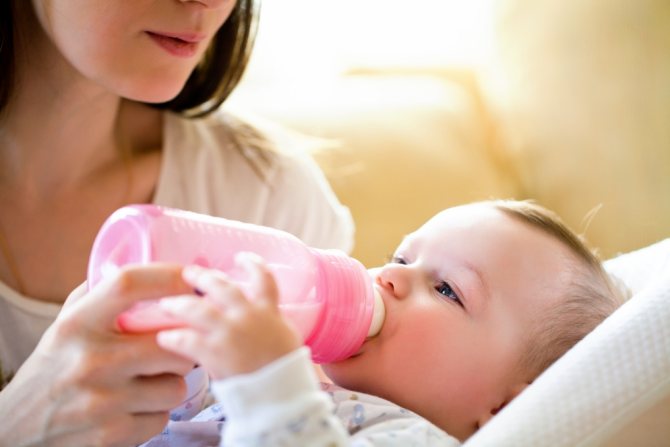
Mixed feeding
For this type of feeding, it is extremely difficult to calculate the norm. The criterion for assessing satiety for this category of children is behavior.
First, the baby is always offered the breast, preferably both, so that while he is hungry he actively eats healthier food. If you see that he is not full, then feed him from a bottle.
The volume of the mixture can be different: from 25 ml to 120. Children on mixed feeding do not last long. This is because mother's milk is difficult to obtain, but formula flows from the bottle almost unhindered. The baby increasingly prefers food from a bottle and soon switches to artificial feeding.
Diet of a three month old baby
How much should a 2 month old baby eat?
Each child is individual, so the mother should choose the frequency of feedings independently or consult a pediatrician. This is especially true for infants on artificial nutrition.
One baby, thanks to his mother's nutritious milk, can be full and not ask for food for 5-7 hours, usually at night. Another little one wants to eat within three hours. Everything is strictly individual.
During the day
The three-month-old baby is already more awake and sleeps less. While awake during the daytime, the child studies the world around him, communicates with mom, dad and other relatives, but most often he eats according to his own schedule. The table below shows an approximate feeding schedule for a 3 month old baby.
Approximate feeding time for a baby during the day
| Feeding | Time |
| 1st feeding | from 9:10 to 9:40 |
| 2nd feeding | from 11:20 to 12:00 |
| 3rd feeding | from 15:20 to 16:00 |
| 4th feeding | from 19:00 to 20:00 |
Feeding times can change for a variety of reasons: getting up late, high-calorie foods, illness, and so on.
At night
At night, the baby should eat approximately three times: at 22:00, 1:30 and 3:30 am. This time is average and cannot be considered as a strict rule.
It often happens that the baby misses one or even two feedings at night. You should not wake him up; when the baby gets hungry, he will wake up on his own, only a little later.
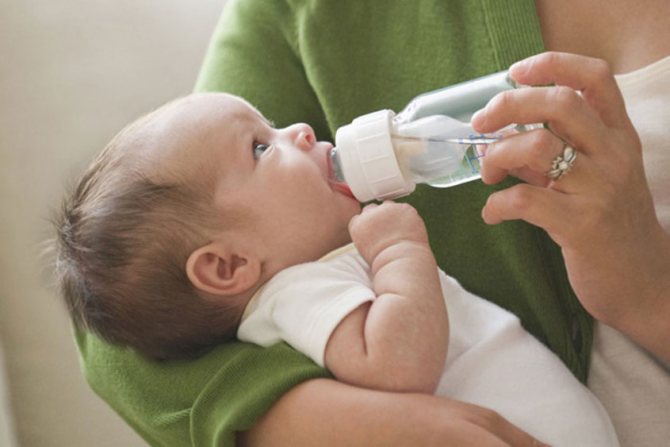
Child drinks water from a bottle
Features of breastfeeding at 3 months
By three months, the baby usually becomes calmer and more predictable.
He is no longer bothered by colic, a semblance of a routine begins to emerge in the baby’s life, and the mother’s lactation becomes mature - milk is not produced spontaneously, but in response to sucking. It would seem that here it is, the opportunity to breathe deeply. Alas. At this age, you will have to face new pitfalls that will not allow you to turn breastfeeding at 3 months into pure pleasure. The most common of them are growth crisis, false breast refusal and lactation crisis. Let's look at each in more detail.
When to give your baby water
How much formula should a 4 month old baby eat?
Whether a baby should be given water at three months depends on the type of feeding, as well as the baby’s health condition and climatic conditions.
When breastfeeding
Modern pediatricians do not recommend supplementing infants with water until they are six months old. As an exception, you can give the child a little water in hot summer weather, when the norm of liquid per feeding for a three-month-old child should be at least 200 ml. If you constantly put your baby to the breast, then breast milk can easily replace this norm, and this “risky” liquid will not enter the baby’s body.
According to studies, it turned out that water that enters the baby’s body helps wash away the protective mucus produced by the gastrointestinal tract. Along with water, third-party microflora can enter the immature intestine, because it is unrealistic to give a child extremely clean water at home.
Artificially fed
For babies who eat only formula, it is simply necessary to supplement their diet with clean water. Calculating your daily water intake is very simple. This is done at the rate of 50 ml per kg of child weight. For example, a baby weighing more than five kilograms should be given 250 ml of clean water per day. This volume does not include the water required to prepare the mixture.
Give one or maximum two teaspoons of water in between feedings or when waking up at night. It is extremely undesirable to exceed this norm, since increased water consumption can disrupt the water-salt balance in the baby’s body, because the baby’s stomach and kidneys are completely immature and remove water from the body for a long time. You should not give your baby water before feeding, as it can greatly reduce his appetite. Water is offered only freshly boiled and at room temperature. You cannot add sugar to it, as this can cause obesity, impaired carbohydrate metabolism and other serious consequences.
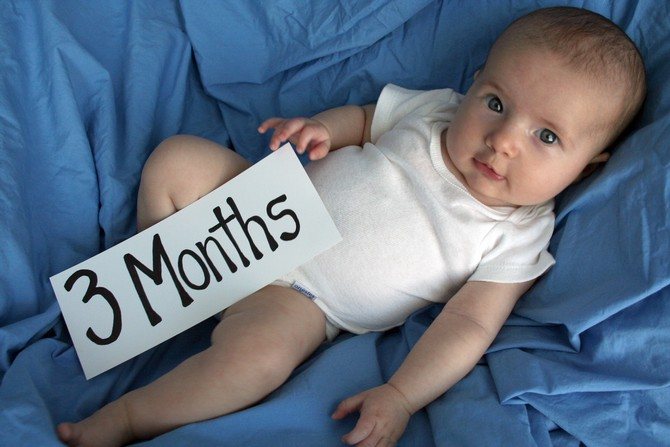
A 3 month old baby lies on a blue blanket in a white bodysuit
Mom has a breastfeeding crisis at 3 months: why does it happen?
This condition is also called a lactation crisis. It is directly related to the growth spurt, and one could not dwell on it if it were not for the panic of many mothers, especially those whose lactation crises at 3 weeks and 1.5 months passed unnoticed by them.
The fact is that the mammary gland needs time to adapt to the increasing demands of a growing child's body. But it often seems to the mother that it is not the child who has begun to eat more, but her production has decreased. Panic state “Milk is disappearing!” provokes stress, and it is not the best assistant to stable lactation.
The recommendations in this case are essentially the same as for a growth spurt: feed on demand, don’t be nervous, get enough sleep and eat well. But resorting to supplementary feeding at 3 months while breastfeeding is not recommended. Monitor the number of urinations: if there are more than 8 per day, there is no need to worry. And remember: after a few days, lactation will definitely return to normal.

How to tell if your baby is full
How much should a 6 month old baby eat?
With any type of feeding, if the baby receives a sufficient amount of food, then immediately after feeding he will fall asleep peacefully. Not only sleep is considered an indicator that the child is full. If the baby has sucked all the formula from the bottle or milk from the breast and does not sleep, but smiles, gurgles, and wants to play, this means that he is full and very happy.
Important! Breastfeeding should be done for at least 15-35 minutes. The interval between meals will depend on the nutritional value of mother's milk or formula.
If the baby is not full while breastfeeding, he drops the breast and begins to cry. The mother should make sure that there is no more milk in the breast with which she fed the baby, and immediately offer him another one. If there is not enough milk, then it is necessary to supplement the baby with formula.
A baby who receives enough breast milk gains weight well. If there is not enough food, the increase will be very low.
Average statistical increase rates for 3 months
| Options | Boys | Girls |
| Weight, gram | 600-1100 | 500-1000 |
| Height, cm | 3-2,5 | 3-2 |
| Chest and head circumference, cm | 2 | 2 |
If the baby is vigorous, cheerful and gaining weight very well, parents should not worry. You can make sure that your baby is really getting enough breast milk by doing a wet diaper test. To do this, you need to leave the baby for a whole day without a diaper and swaddle him in regular diapers.
If you get 12-18 wet diapers throughout the whole day, then there is no reason to worry, the baby’s nutrition is in perfect order.
How to tell if your baby is getting enough nutrition at 3 months
It is very easy to understand whether a child has enough nutrition. Just look at his behavior after eating. This may be a dream - the most common sign that a child is full. If the baby strives to communicate, is cheerful and cheerful, then there is no need to supplement him.
One feeding can last from 16 to 36 minutes. This time depends on the nutritional value of breast milk or the calorie content of the formula. If a baby does not eat enough, this is immediately evident from his behavior. You can understand that there is not enough breast milk if the baby continues to suckle and at the same time whines, is capricious, sometimes even gets angry and clenches his jaw tightly. In this case, the mother gives the second breast. But sometimes this doesn’t help and the baby doesn’t get enough to eat. Only in this case should you resort to supplementary feeding from a bottle.
Babies who receive adequate amounts of formula or breast milk gain weight as expected. If the baby does not receive enough nutrition, then the weight gain will be insignificant. For three-month-old boys, the norm is to add 600-1000 grams, for girls – 500-1000 grams.
There is another way to check if your baby is getting enough breast milk. To do this, you need to not use diapers for one day and count wet diapers. If their total number per day is 12-19, then you don’t have to worry and don’t look for an answer to the question of how much a child should eat.
If your child eats less than normal
Poor appetite in a child can be caused by any situation:
- Illness, for example, acute respiratory infection or stomatitis.
- Changed environment, such as moving, being away for a long time, not getting enough sleep.
- Climate change, especially intense heat in the summer.
- Changing the diet, switching to a different mixture. Or the mother ate something unsuitable for the child’s body, and he does not like the taste of the milk at all.
All these factors have a short-term effect on changes in appetite in infants. If the baby does not eat well for two days, then you should urgently consult a doctor.
Deviations from the norm during breastfeeding
All children are individual from birth. In case of prematurity, pediatricians do not react at all to many deviations from the norm. And the norms for babies born with high weight differ significantly from those accepted for average children.
What to do if a child eats less than normal?
The main thing is not to panic! Poor appetite can be caused by anything.
- Disease, for example, ARVI, stomatitis.
- Changes in the environment, such as moving, staying away for a long time, lack of sleep.
- Climate change, especially a sharp increase in temperature to high levels in the summer.
- Change of diet, transition to a new mixture. Or maybe the mother ate something inappropriate and the baby doesn’t like the taste of the milk.
All these factors have a short-term effect on changes in appetite. But if the baby does not eat well for two days, then you need to consult a doctor.



